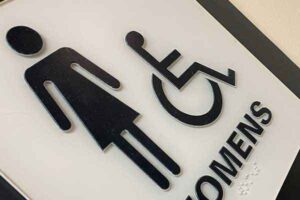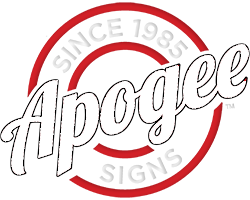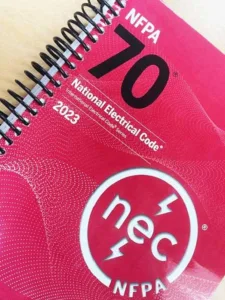
In the United States, accessibility and inclusivity are cornerstones of societal progress. The Americans with Disabilities Act (ADA), enacted in 1990, stands as a testament to the nation’s commitment to providing equal access to public spaces for individuals with disabilities. A fundamental aspect of achieving this goal lies in the meticulous design and placement of ADA signs. These signs serve as essential beacons of information, offering crucial guidance and communication within public spaces. In this comprehensive article, we will delve into the precise requirements for ADA signs in public areas, meticulously outlined and regulated by the United States government.
The ADA’s stringent signage requirements are overseen by the U.S. Department of Justice (DOJ) and the U.S. Access Board, ensuring that individuals with disabilities can navigate public spaces with confidence and autonomy. ADA-compliant signs are more than just a legal obligation; they are a testament to our collective commitment to inclusivity and accessibility. Through the prism of the ADA’s detailed specifications, this article will shed light on the precise standards that govern the design, placement, and attributes of these vital signs, underpinning the principles of equal access for all.
Types of ADA Signs
The realm of ADA signs is a multifaceted landscape, encompassing various categories meticulously crafted to meet the specific needs of public spaces. These categories are strategically designed to bolster accessibility and inclusivity, serving as vital components that enable individuals with disabilities to navigate their surroundings confidently and seamlessly. Within this intricate tapestry of signage, we introduce four essential types of ADA signs, each playing a pivotal role in realizing the overarching goal of equal access and inclusivity:
These signs serve as invaluable aids in helping individuals identify rooms and spaces within a building. Typically, they feature prominently displayed room numbers, room names, and essential Braille information. By providing this comprehensive information, room identification signs empower people to pinpoint and access specific destinations within a facility, promoting autonomy and ease of movement.
Directional signs are the unsung heroes of public spaces, providing indispensable guidance to navigate complex environments efficiently. Through the strategic use of clear arrows, universally understood symbols, and informative text, these signs indicate pathways to critical areas such as restrooms, exits, elevators, and other essential locations. In doing so, they facilitate a seamless flow of movement, ensuring that individuals with disabilities can traverse public spaces with confidence and clarity.
Informational signs serve as invaluable sources of essential knowledge within public spaces. These signs convey vital instructions pertaining to restrooms, ADA compliance guidelines, or emergency evacuation procedures. Their role is pivotal in ensuring that everyone, regardless of their abilities, has equitable access to crucial information. Informational signs promote safety, awareness, and a deeper understanding of the environment.
Often overlooked but of utmost importance, exit signs must adhere rigorously to ADA standards. These signs shoulder the critical responsibility of clearly and unmistakably indicating the path to exits and emergency exits. In emergency situations, they are lifelines, guiding individuals to safety. Therefore, the meticulous design and placement of ADA-compliant exit signs are essential for the safety and well-being of all individuals within a building.
Comprehending these distinct categories of ADA signs is paramount in the pursuit of creating inclusive environments where equal access and autonomy are not mere aspirations but guiding principles of design and implementation. These signs are the tangible embodiment of a commitment to inclusivity, ensuring that individuals with disabilities can participate fully in the rich tapestry of public life.
ADA’s Signage Requirements
The ADA includes specific regulations for signage to ensure that individuals with disabilities can easily navigate public spaces. The U.S. Department of Justice (DOJ) and the U.S. Access Board oversee these regulations. Here are some key requirements:
Visual Characters and Pictograms:
ADA-compliant signs must utilize non-glare materials and provide a high-contrast between characters and the background. This ensures visibility and readability under various lighting conditions.
Tactile characters, including letters, numbers, and Braille, should be raised to allow touch recognition. Braille dots must adhere to precise spacing and height standards, enabling individuals with visual impairments to read and understand the information presented.
Pictograms or symbols on signs should not only be easy to understand but also raised to provide tactile information. This tactile feature enhances accessibility for those who rely on touch cues for navigation and comprehension.
These meticulous requirements for visual characters and pictograms on ADA signs collectively contribute to a more inclusive and accessible environment for individuals with disabilities in public spaces.
Lettering and Character Height:
The careful selection of letter height in ADA signs, ranging from 5/8 inch (16 mm) to 2 inches (51 mm), ensures optimal visibility without compromising readability for individuals with varying visual needs. Moreover, maintaining the prescribed width-to-height ratio, falling between 3:5 and 1:1, guarantees that characters are proportionate and legible, a critical consideration for facilitating accessibility, especially for those with visual impairments.
The careful selection of letter height in ADA signs, spanning from 5/8 inch (16 mm) to 2 inches (51 mm), ensures optimal visibility without compromising readability for individuals with varying visual needs. This range strikes a balance, offering clear visibility without being too small or too large.
To maintain legibility and proportion, characters on ADA signs should adhere to a specific width-to-height ratio, ranging between 3:5 and 1:1. This means that the width of the characters should be between 60% and 100% of their height. This precise ratio ensures that characters are neither excessively stretched nor condensed, contributing to ease of reading, especially for individuals with visual impairments.
In certain design contexts, lowercase characters can be employed for tactile elements on signs while still complying with the specified height and spacing guidelines. This flexibility can be beneficial, allowing for a more aesthetically pleasing and informative sign design while maintaining strict ADA compliance standards.
Typeface:
Typeface selection is a crucial element in the intricate world of ADA signage design. It’s a choice that directly influences the legibility and accessibility of these signs, carrying significant weight in ensuring that vital information reaches everyone, regardless of their visual abilities. In this section, we delve into the meticulous considerations governing typefaces for ADA signs, from the preference for sans-serif fonts to the emphasis on clarity and the harmonious blend of upper and lowercase characters. These principles underpin the creation of signs that not only communicate effectively but also offer a visually appealing and user-friendly experience in public spaces.
ADA regulations mandate the use of sans-serif fonts characterized by clean, simple lines without decorative strokes or serifs. Sans-serif fonts are preferred for their enhanced clarity and readability, particularly at a distance or in low-light conditions.
The chosen typeface should not only be sans-serif but also easily legible. This entails ensuring that characters remain clear and distinguishable, even when viewed from a distance or at small sizes. Clarity is paramount to ensure that individuals with visual impairments or reading difficulties can accurately interpret the information on the sign.
ADA sign requirements stipulate the use of both upper and lowercase characters. This combination enhances comprehension and readability by mimicking standard sentence structure and aiding in word recognition. Additionally, the use of both cases contributes to a more aesthetically balanced and harmonious design, ensuring that ADA-compliant signs not only convey information effectively but also offer a visually appealing and user-friendly experience in public spaces.
Braille:
Braille, a fundamental element of ADA signage, plays a vital role in ensuring accessibility for individuals with visual impairments. To meet these requirements effectively:
ADA signage should feature Grade 2 Braille, a standardized system that incorporates contractions and abbreviations, enhancing efficiency in reading and comprehension for individuals who are blind or have visual impairments.
In addition to Grade 2 Braille, meticulous adherence to specific spacing and dot height standards is paramount. These standards maintain consistency in the height and spacing of tactile characters, improving the readability and tactile discernibility of Braille for those who rely on it for information and navigation. This unwavering attention to detail underscores the unwavering commitment to accessibility and inclusivity within public spaces.
Signage Mounting and Location:
Effective signage mounting and positioning are pivotal in enhancing accessibility within public spaces. In this section, we delve into the meticulous considerations governing the placement of ADA signs:
Properly mounting ADA signs on the latch side of the door is essential. This placement ensures that individuals can effortlessly locate and read the sign as they approach the door, facilitating seamless navigation within the space.
The height at which ADA signs are installed is another critical factor. These signs should be positioned at a height between 48 inches (1219 mm) and 60 inches (1524 mm) above the finished floor. This carefully selected range accommodates a diverse range of individuals, including those who use wheelchairs or mobility devices, as well as those with different heights or visual impairments.
Additionally, ADA signs should be located in close proximity to the door they identify. This proximity ensures that the signs are readily noticeable and directly relevant to the immediate area, further enhancing the ease with which individuals can access the desired location or facility. The meticulous placement and positioning of ADA signs are integral to fostering inclusivity and ensuring that everyone can navigate public spaces with dignity and independence.
Finish and Contrast:
In the world of ADA signage, attention to detail is paramount for ensuring equitable access, particularly for individuals with visual impairments. Here, we explore the crucial aspects of finish and contrast in ADA signage, from non-glare finishes to contrast considerations. These elements, when thoughtfully incorporated into signage design, align with the core principles of the Americans with Disabilities Act (ADA) and promote equal access and inclusivity in public spaces.
To ensure that ADA signs are easily readable and free from distracting reflections, a non-glare finish is of paramount importance. This finish minimizes unwanted glare, catering to individuals with various visual sensitivities and ensuring legibility in diverse lighting conditions. The absence of glare is a fundamental aspect of making ADA signage accessible and user-friendly for everyone.
Contrast serves as a cornerstone in making ADA signs comprehensible to all individuals. Both the characters and the background must maintain a sufficient level of contrast to guarantee legibility. Typically, this involves utilizing light characters on a dark background or vice versa. Striking this balance is essential, as insufficient contrast can impede readability, while excessive contrast can create visual discomfort. A strong contrast is particularly valuable for individuals with low vision or color blindness, aiding them in distinguishing the information presented on the sign.
Incorporating these meticulous finish and contrast considerations into ADA signage design aligns seamlessly with the overarching goal of the ADA: fostering equal access and inclusivity for all individuals within public spaces. These elements not only enhance the functional aspects of signage but also contribute to creating a more welcoming and user-centric environment where accessibility is a fundamental right.
Compliance and Enforcement of ADA Sign Requirements
Ensuring stringent compliance with ADA sign requirements is an essential pillar of creating truly accessible and inclusive public spaces. The repercussions of non-compliance extend beyond mere regulatory violations, impacting the accessibility and rights of individuals with disabilities. In the United States, the Department of Justice (DOJ) assumes the pivotal role of enforcing ADA compliance in public facilities, wielding the authority to impose substantial penalties for non-conformance.
The ADA’s stringent requirements for signage are not mere guidelines but legally binding regulations designed to safeguard the rights and dignity of individuals with disabilities. Compliance ensures that these individuals can navigate public spaces with the same ease and confidence as anyone else, fostering a society that values inclusivity and equal access. Non-compliance, conversely, not only constitutes a breach of these legal obligations but also creates physical and psychological barriers for those who rely on ADA-compliant signs for information and direction.
The DOJ’s enforcement mechanisms serve as a critical deterrent against non-compliance, signaling that the federal government takes accessibility seriously. Facilities found in violation of ADA signage standards may face not only financial penalties but also the obligation to rectify the issues promptly. In essence, the enforcement of ADA sign requirements underscores the commitment to upholding the principles of equal access and inclusion, safeguarding the rights of all individuals within public spaces.
Importance of ADA Signage
The significance of ADA signage transcends mere legal compliance; it stands as a powerful tool for promoting inclusivity and equitable access for all individuals. By adhering to the meticulously crafted guidelines and regulations established by the U.S. government, public spaces can pave the way for an environment where people with disabilities can navigate with unparalleled ease and confidence.
ADA signage embodies the principle of inclusivity at its core. It acknowledges and accommodates the diverse needs of individuals with disabilities, recognizing their right to engage fully in public life. These signs break down barriers, fostering a sense of belonging and participation within society for everyone.
ADA signage is a tangible manifestation of the commitment to equal access. It transcends physical barriers, ensuring that individuals with disabilities can access and utilize public facilities with the same level of dignity and independence as their peers. It is a testament to the nation’s dedication to leveling the playing field for all.
These signs are not mere decorations; they are a vital means of clear communication. They convey essential information, guide individuals to their destinations, and provide critical instructions. In doing so, they bridge the gap in communication that might otherwise hinder individuals with disabilities from fully comprehending and engaging with their surroundings.
ADA signage empowers individuals by granting them the information and tools needed to navigate public spaces autonomously. This empowerment enhances self-confidence, as individuals with disabilities can rely on these signs to navigate complex environments without dependence on others.
The principles behind ADA signage often spill over into universal design, benefiting a broader spectrum of people beyond those with disabilities. Signage designed for accessibility often proves more intuitive and user-friendly for all individuals, creating a more welcoming and user-centric environment.
In essence, ADA signage embodies the essence of a more inclusive and compassionate society. It goes beyond fulfilling legal obligations, serving as a beacon of our collective commitment to equal opportunities and the removal of barriers for individuals with disabilities. By embracing these principles, public spaces become catalysts for societal progress, where everyone, regardless of their abilities, can participate fully and contribute to the rich tapestry of community life.
In Conclusion
The ADA’s stringent regulations governing signage in public spaces are not just a legal obligation but a cornerstone of societal progress towards accessibility and inclusivity. Adherence to these meticulously crafted requirements ensures that individuals with disabilities can access and utilize public facilities with the utmost dignity and independence.
By embracing these factual, data-driven guidelines, public spaces become more than just physical structures; they transform into beacons of inclusivity, extending a warm and equitable welcome to all. These ADA signs are not mere symbols; they are tangible embodiments of our commitment to a society where everyone can participate fully in public life, irrespective of their abilities.
As we reflect on the importance of ADA signage, let us remember that it is not solely a matter of compliance; it is a testament to our shared values of equality, respect, and the relentless pursuit of a more inclusive world where every individual’s potential can shine. These signs are, quite literally, the signposts guiding us toward a brighter, more equitable future.
*All information was collected across various sources. Due to regular changes or updates to the compliance regulation, please visit the US Government ADA website for the most up to date information.






